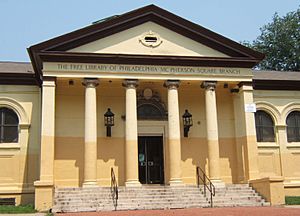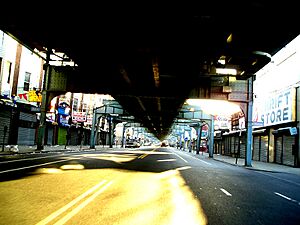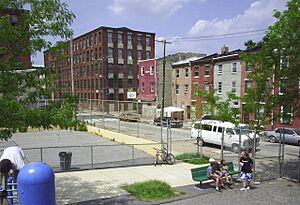Kensington, Philadelphia facts for kids
Quick facts for kids
Kensington
|
|
|---|---|

Beatty's Mills Factory Building, a historic textile mill that is now the Coral Street Arts House, which provides artists with low-income housing
|
|
| Country | United States |
| State | Pennsylvania |
| County | Philadelphia |
| City | Philadelphia |
| Area code(s) | 215, 267, and 445 |
Kensington is a neighborhood in Philadelphia. It's part of the Lower Northeast area. Like many neighborhoods in a big city, Kensington's exact borders can change. People who live there often have their own ideas about where it begins and ends.
Generally, Kensington includes areas like East Kensington, West Kensington, and Harrowgate. Nearby neighborhoods like Fairhill and Norris Square are sometimes included too. In the past, Fishtown and South (Olde) Kensington were also part of Kensington.
Kensington is mostly a working-class area. Many jobs were lost in the 1960s when factories closed. This led to more poverty and many empty buildings. But people in the neighborhood have started many local groups to help improve things.
Kensington is home to many different people. There are many Hispanic Americans, especially Puerto Ricans and Dominicans. There are also African Americans, Irish Americans, Polish Americans, and Asian Americans. Some areas of Kensington have recently seen new people moving in. These are often young professionals, which has led to changes in the neighborhood.
Contents
Exploring Kensington's Location
The exact borders of Kensington have changed over time. Before 1854, the old Kensington District included parts of what are now Olde Kensington, East Kensington, West Kensington, and Fishtown. Fishtown is now seen as a separate neighborhood.
Today, Kensington's main borders are Front Street and 5th Street to the west. The Amtrak train tracks are to the north. Trenton Avenue, its train tracks, and Frankford Avenue are to the east. Cecil B. Moore Avenue is to the south. Some people simply describe Kensington as a triangle. This triangle is bordered by Erie Avenue to the north, Front Street to the west, and Trenton Avenue to the east.
Kensington is part of the River Wards section of Philadelphia. These neighborhoods are close to the Delaware River. This gives Kensington a different feel from neighborhoods further west.
Different Parts of Kensington
Kensington has several smaller areas inside it. These include Harrowgate, Lower Kensington, and West Kensington.
Central Kensington is sometimes called "the Heart of Kensington." It runs along Kensington Avenue. This area used to be the main shopping and business center.
The part of Kensington below Lehigh Street is sometimes called "Lower Kensington" or "East Kensington." This area is seeing a lot of new development. Since it's close to Fishtown, more people with higher incomes are moving in. This can make housing more expensive.
West Kensington is similar to Norris Square and Fairhill. It has a similar mix of people to the rest of Kensington. It is still considered a clear part of Kensington.
Kensington's Rich History
Kensington was started in the early 1730s by a man named Anthony Palmer. He bought land along the Delaware River. Palmer was an English merchant who came from Barbados.
The town was named after Kensington in London, England. This was where the British royal family lived. Palmer sold land to shipbuilders and fishermen. These workers needed more space than they had in other parts of Philadelphia. The original area of Kensington is now often called "Fishtown." This is because shad fishing was a very important business there.
Kensington became known as a center for working-class people. At first, jobs were mostly about fishing and building ships. Later, in the 1800s, Kensington became a place for iron and steel factories. It also had many potteries and machine shops.
Kensington was also home to a large working-class Irish Catholic community. In the 1800s, there were some difficult times and conflicts in the area.
By the mid-1800s, Kensington was a leader in the textile industry, especially for making carpets. In 1903, Mother Jones led a "Children's Crusade." This was a march of children who worked in local mills and mines. They protested against child labor. They marched all the way to Oyster Bay, New York. They carried signs that said, "We want to go to School and not the mines!"
In the 1950s, many factories in Kensington closed down. This is called deindustrialization. It led to fewer people living there, many job losses, and empty homes. However, some parts of the neighborhood have been improving recently. This is especially true near Frankford Avenue and Fishtown. While most big factories are gone, there are now many small shops. Old factories and warehouses have been fixed up for new artists and businesses.
Historic Places in Kensington
Many buildings in Kensington are important because of their history. Some are listed on the National Register of Historic Places. This means they are recognized as special places in American history.
- The 26th District Police and Patrol Station
- Beatty's Mills Factory Building
- H.W. Butterworth and Sons Company Building
- Kensington High School for Girls
- Philip H. Sheridan School
Other buildings are listed on the Philadelphia Register of Historic Places. This means they are important to Philadelphia's history.
- Clifton Mills (1833 N. Howard Street)
- Clifton Mills, Building 4 (1809-11 N. Howard Street)
- The Columbia Works (155-59 Cecil B. Moore Avenue)
- The Decorating Plant of Gillinder & Sons' Franklin Flint Glass Works (1700-06 N. Howard Street)
- Frankford Avenue Baptist Church (2347-49 Frankford Avenue)
- Harbisons' Dairies (2041-55 Coral Street). This building has a famous water tower shaped like a milk bottle!
- Kensington Hospital for Women (128-40 Diamond Street)
- Peter Woll & Sons, Curled Hair & Bristles (173 W. Berks Street)
- Second Associate Presbyterian Church (1523-25 N. Front Street)
- The Star Carpet Mills (1801-03 N. Howard Street)
- Weisbrod & Hess' Loading Room, Condenser & Storage/Boiler & Wash House (2117 E. York Street)
Who Lives in Kensington?
About 42,000 people live in Kensington. Most of the people are Hispanic or Latino (about 60%). Many are from Puerto Rico or the Dominican Republic. Other groups include White (19%), Black or African American (15.1%), and Asian (3.6%).
The average yearly income in Kensington is about $28,368. Many residents (about two-thirds) are considered "poor or struggling." Most people in Kensington rent their homes, about 55.6% of all homes.
Changes in the Neighborhood
Because many people in Kensington rent their homes and have lower incomes, they can be at risk of being forced to move. This happens when rents go up a lot. This is called gentrification. It means that new, wealthier people move into a neighborhood. This can make property values and rents rise.
Young professionals often want to live close to Center City. Kensington is a good spot because the SEPTA Market–Frankford Line train goes right to Center City. This makes for short travel times. Fishtown, which used to be part of Kensington, has changed a lot. It now has many wealthy residents and new buildings. This change is also happening in Olde Kensington, Norris Square, and East Kensington.
Fun in Kensington: Parks and Gardens
Kensington has many parks and playgrounds. They offer different activities for everyone.
Some parks in and near Kensington include:
- Harrowgate Park
- McPherson Square
- Hope Park
- Fairhill Square Park
- Norris Square Park
- Mascher Park
- Frankford Avenue Garden
- Arcadia Commons
- Trenton and Auburn Park
- Letterly Green
- Emerald Park
- Konrad Square
- Palmer Park
There are also many playgrounds for kids:
- Nelson Playground
- Waterloo Playground
- Hissey Playground
- McPherson Square Playground
- Heitzman Recreation Center
- McKinley Playground / McVeigh Recreation Center
- Scanlon Playground and Ice Rink
- Harrowgate Park Playground
- Fairhill Square Park Playground
- Eric Casiano Field
- Mascher Park / Maguire Playground
- Black Coyle and McBride Playground
- Pop's Playground
- Pop's Skatepark
- Hagert Street Playground
- Shissler Recreation Center
- Towey Playground
Many community groups in Kensington have turned empty lots into beautiful community gardens. These gardens are places where people can grow food and enjoy nature. Some of these gardens are:
- Kensington Corridor Trust Community Garden
- NKCDC Garden
- Las Parcelas - Norris Square
- El Batey - Norris Square
- Collins Smith Barrick Play Garden
- Emerald Street Community Farm
- Rainbow Park
- House of Grace Community Garden
- Port Kensington
- Hart Lane Farm
- Circle of Hope / Frankford Ave Garden
Community Action in Kensington
People in Kensington are very active in making their neighborhood better.
Protests for Change
Somerset Station Train Closure
In March 2021, the SEPTA train company closed the Somerset Station on the Market–Frankford Line. This happened suddenly and without telling residents beforehand. SEPTA said it was to fix damage and make things safer for workers. But closing the station for a long time made it hard for many residents to travel.
Hundreds of Kensington residents marched to protest this closure. They walked from Somerset Station to Allegheny Station. This was the longer trip many had to take now. Protesters demanded that the station reopen soon. They also asked for safer conditions for SEPTA workers and help for people without homes. The station reopened on April 5 with more police present.
Helping the Community Grow
Community Development Groups
Kensington has many groups called community development corporations. These groups work to improve homes and businesses in the neighborhood.
- Impact Services helps with many things. This includes job training, affordable housing (especially for veterans), and community projects.
- HACE focuses on building and improving homes and businesses. They also help with housing and small business services.
- New Kensington CDC works on building projects and getting the community involved. They also offer direct help to prevent people from losing their homes.
- Kensington Corridor Trust helps bring life back to empty buildings on Kensington Avenue. They want to create jobs and help the local economy. They use a special model where community members help decide how the area develops.
Religious Organizations
- Rock Ministries was started in 2003. It helps people in need. They offer free boxing lessons for kids if they attend a short Bible study.
Local Associations
Many local groups help neighbors work together.
- Somerset Neighbors for Better Living
- Harrowgate Civic Association
- Kensington Independent Civic Association
- Kensington Neighborhood Association
- Olde Richmond Civic Association
- South Port Richmond Civic Association
- East Kensington Neighbors Association
Learning in Kensington
Schools for All Ages

The School District of Philadelphia runs the public schools in Kensington. Some of these schools are:
- Kensington High School Complex
- Jules E. Mastbaum Vocational Technical High School
- Russell H. Conwell Middle Magnet School
- John H. Webster Elementary School
There is also a charter school called Sankofa Freedom Academy Charter School.
In 2011, three Catholic schools in Kensington closed. This was because fewer students were attending them. These schools were Ascension of Our Lord, St. Anne, and St. Hugh of Cluny.
Public Libraries
The Free Library of Philadelphia has two branches in Kensington:
- The McPherson Square Branch at 601 East Indiana Avenue
- The Kensington Branch at 104 W Dauphin Street
Famous People from Kensington
Many talented people have come from Kensington!
- !PAUS3, a professional musician
- Eddie Alvarez, a mixed martial artist
- Samuel B. Booth, a church leader
- Frank Cappuccino, a boxing referee
- Shane Claiborne, a founding member of The Simple Way religious group
- Emanual Davis, a basketball player
- Jehu Eyre, a shipbuilder during the American Revolutionary War
- Edwin Henry Fitler, a former mayor of Philadelphia
- William J. Green, III, a politician and former mayor of Philadelphia
- Drew Gulak, a professional wrestler
- Joseph Hallman, a composer
- John Hewson, a textile producer
- Amos Lee, a singer-songwriter
- Roberto Lugo, an artist
- Jonathan Maberry, an author
- Benny McLaughlin, a soccer player
- Bob McNeill, a basketball player
- Jamie Moffett, a filmmaker
- Eddie Stanky, a baseball player
- John J. Taylor, a politician



